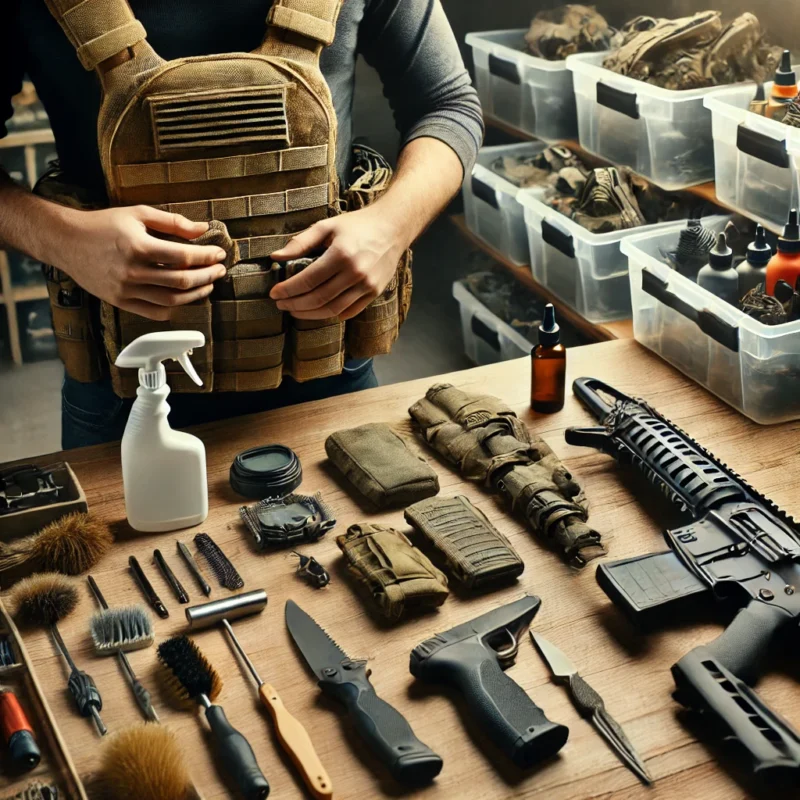Gear
Essential Tips for Maintaining Your Tactical Gear
Tactical gear is an investment in safety, performance, and efficiency. Whether you’re an airsoft enthusiast, a survivalist, or a professional in the field, maintaining your tactical gear is crucial to ensure it functions correctly when you need it most. This article covers essential tips and best practices for keeping your gear in top condition, prolonging its lifespan, and ensuring it performs at its best in any situation.
1. Regular Inspection and Cleaning One of the fundamental aspects of gear maintenance is regular inspection and cleaning. Dirt, grime, and moisture can damage equipment over time, so it’s essential to clean your gear after every use.
- Inspect for Damage: Before and after each use, inspect your gear for any signs of wear and tear. Look for frayed straps, broken buckles, and other signs of damage.
- Cleaning: Use mild soap and water to clean your gear. Avoid harsh chemicals that can degrade materials. For items like backpacks and clothing, follow the manufacturer’s cleaning instructions.
- Drying: Ensure your gear is thoroughly dried before storing it. Moisture can lead to mold, mildew, and rust, especially on metal parts.
2. Proper Storage Solutions How you store your tactical gear significantly impacts its longevity. Proper storage prevents unnecessary wear and protects your gear from environmental damage.
- Cool, Dry Place: Store your gear in a cool, dry place away from direct sunlight. UV rays can weaken fabrics and fade colors.
- Organized Storage: Use bins, shelves, or racks to keep your gear organized. Keeping everything in its place makes it easier to inspect and maintain.
- Avoid Overloading: Don’t overstuff storage spaces. Allow enough room for your gear to maintain its shape and avoid unnecessary stress on materials.
3. Maintenance of Specific Gear Types Different types of gear require specific maintenance practices. Here are some tips for maintaining common tactical gear:
- Backpacks and Bags: Clean regularly and check for loose stitching. Lubricate zippers with a graphite pencil or a specialized lubricant.
- Clothing and Footwear: Follow the manufacturer’s washing instructions. Waterproof footwear as needed and replace insoles periodically.
- Protective Gear: Clean helmets, vests, and pads with mild soap and water. Inspect for cracks and replace any compromised components.
- Weapons and Tools: Regularly clean and oil moving parts. Store in a dry place to prevent rust. Sharpen blades and replace worn-out parts as necessary.
4. Extending the Life of Electronic Gear For those who use electronic equipment such as radios, GPS devices, and night vision goggles, proper maintenance is crucial for ensuring these devices function correctly when needed.
- Battery Care: Remove batteries when storing devices for extended periods to prevent corrosion. Regularly check and replace batteries to ensure your equipment is always ready for use.
- Protect from Moisture: Use waterproof cases or pouches to protect electronic gear from moisture. Ensure devices are thoroughly dried if they get wet.
- Firmware Updates: Keep your electronic gear updated with the latest firmware to ensure optimal performance and security.
5. Regular Training and Familiarization Maintaining your gear isn’t just about physical care; it also involves regular training and familiarization with your equipment.
- Regular Use: Regularly use your gear in training scenarios to stay familiar with its operation and to identify any issues early.
- Training Drills: Conduct training drills that incorporate the use of all your gear. This practice ensures you know how to use everything correctly and efficiently.
- Feedback Loop: After each use, gather feedback on gear performance. Note any issues or discomforts and address them promptly.
6. Keeping a Maintenance Log Maintaining a log of all your gear maintenance activities can be incredibly beneficial.
- Track Maintenance: Record each time you clean, inspect, or repair your gear. This helps ensure you don’t miss any necessary maintenance tasks.
- Note Issues: Keep notes on any recurring issues or parts that frequently need replacing. This information can be useful for upgrading or purchasing new gear in the future.
- Scheduled Checks: Set up a regular schedule for comprehensive gear checks, especially before and after major operations or trips.
7. Knowing When to Replace Gear Even with the best maintenance practices, there comes a time when gear needs to be replaced.
- Recognizing Wear and Tear: Learn to recognize the signs that gear is beyond repair. For example, persistent fabric fraying, irreparable zippers, or compromised protective elements.
- Manufacturer’s Lifespan: Pay attention to the manufacturer’s recommended lifespan for gear and components. Some items have a finite period during which they are guaranteed to perform effectively.
- Upgrading: Keep abreast of new gear innovations. Sometimes replacing older gear with newer models can significantly enhance performance and safety.
Proper maintenance of your tactical gear is not just about prolonging its life; it’s about ensuring it performs when you need it most. By incorporating these essential tips into your routine, you can protect your investment and stay prepared for any situation. Remember, in the world of tactical operations, your gear is only as reliable as the care you give it.
Have any maintenance tips or experiences you’d like to share? We’d love to hear from you! Share your thoughts in the comments below and join the conversation about keeping our tactical gear in top shape.


